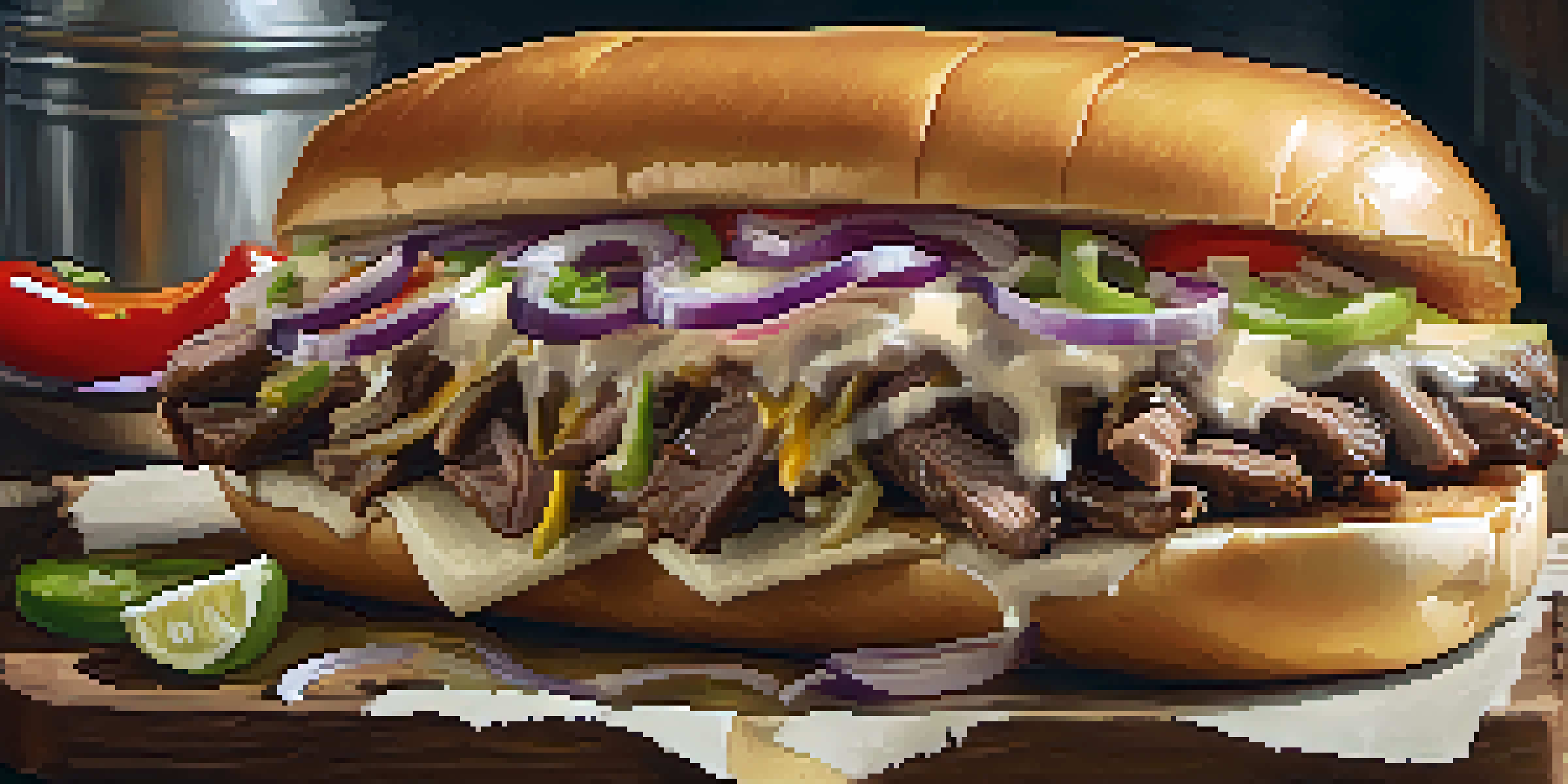The Philly Cheesesteak: A Deep Dive into Its Origins

The Birth of the Philly Cheesesteak in Philadelphia
The Philly cheesesteak has its roots in the vibrant city of Philadelphia, where it originated in the 1930s. Legend has it that a hot dog vendor named Pat Olivieri created the first sandwich by grilling beef on his hot dog stand. As he shared his creation with a cab driver, the cheesesteak was born, quickly capturing the hearts and appetites of locals.
Food is our common ground, a universal experience.
This humble sandwich began as a simple combination of thinly sliced beef and onions, served on a fresh hoagie roll. Its popularity skyrocketed, leading to the establishment of iconic shops like Pat’s King of Steaks and Geno’s Steaks. These establishments have become landmarks for cheesesteak enthusiasts, each claiming to serve the “authentic” version.
The cheesesteak's rise to fame is a testament to Philadelphia's rich culinary scene, showcasing how a simple idea can evolve into a beloved dish. Today, it stands not only as a staple of Philly cuisine but also as a symbol of the city's food culture.
Key Ingredients That Define the Cheesesteak
At the heart of every cheesesteak are a few key ingredients that make it irresistible. The most crucial component is the beef, typically ribeye, known for its tenderness and flavor. This meat is sliced thinly and cooked on a griddle, allowing it to sear while retaining juicy goodness.

Onions often accompany the beef, caramelized to bring out their natural sweetness. Some fans swear by adding cheese, with Cheez Whiz, provolone, or American cheese being the most popular choices. Each cheese option adds a distinct flavor and texture, elevating the overall experience.
Origin of the Philly Cheesesteak
The Philly cheesesteak was created in the 1930s by Pat Olivieri in Philadelphia, evolving from a simple beef and onion sandwich into a cultural icon.
Finally, the bread must be fresh and sturdy enough to hold the fillings without falling apart. The classic hoagie roll is the preferred choice, with its soft interior and slight crust, perfectly complementing the savory filling. Together, these ingredients create a symphony of flavors that have delighted taste buds for decades.
Regional Variations of the Classic Cheesesteak
While the classic Philly cheesesteak reigns supreme, regional variations have emerged, each adding its own twist to this iconic dish. For instance, in other parts of Pennsylvania, you might find cheesesteaks topped with sautéed mushrooms or hot peppers, showcasing personal preferences.
The only thing better than talking about food is eating it.
Beyond Pennsylvania, the cheesesteak has made its way across the United States, with places like California offering their take on it. Here, you might stumble upon cheesesteaks loaded with avocado or chipotle mayo, reflecting the local flavors and culinary creativity.
These variations highlight the cheesesteak's versatility and adaptability, proving that while it has a defined origin, it can evolve and thrive in different culinary landscapes. This adaptability continues to keep the cheesesteak relevant and exciting for food lovers everywhere.
The Cheesesteak's Cultural Impact and Popularity
The Philly cheesesteak is more than just a sandwich; it represents a significant part of Philadelphia's identity. It has become a staple at sporting events, street fairs, and family gatherings, often enjoyed by locals and tourists alike. The thrill of biting into a cheesesteak is something that many associate with their experiences in the city.
Moreover, the sandwich has gained national and international recognition, inspiring countless imitations and adaptations. Food festivals, cooking shows, and social media have all contributed to its fame, with chefs putting their unique spins on the classic recipe. This exposure has only solidified its status as a beloved American dish.
Key Ingredients Matter
Essential ingredients like ribeye beef, fresh hoagie rolls, and various cheese options define the cheesesteak and contribute to its irresistible flavor.
The cheesesteak's cultural significance goes beyond its flavor; it embodies the spirit of Philadelphia and the pride of its residents. As a symbol of unity and community, it brings people together over delicious food, making it a cherished part of the city's heritage.
Making the Perfect Philly Cheesesteak at Home
You don't have to be in Philadelphia to enjoy a delicious cheesesteak; you can make your own at home! Start by choosing high-quality ribeye steak, slicing it thinly against the grain, and marinating it for added flavor. This step ensures that the meat is tender and packed with taste.
Next, heat a griddle or skillet to a high temperature, where you can quickly cook the steak and onions together. The key is to achieve that perfect sear while keeping the meat juicy. Don’t forget to layer on your choice of cheese just before removing it from the heat, allowing it to melt beautifully over the steak.
Finally, serve your homemade cheesesteak on a fresh hoagie roll, accompanied by your favorite toppings, whether that's sautéed peppers, hot sauce, or even a drizzle of aioli. With a few simple steps, you can recreate the magic of a Philly cheesesteak in your kitchen, bringing a taste of Philadelphia to your table.
Cheesesteak Controversies and Debates
With great popularity comes great debate, and the Philly cheesesteak is no exception. One of the most heated discussions revolves around the choice of cheese. While some purists argue that only Cheez Whiz will do, others prefer provolone or American cheese for a more gourmet experience. This debate often leads to spirited discussions among cheesesteak aficionados.
Another point of contention is the addition of toppings. Should you add ketchup, or is that sacrilege? Some traditionalists believe that a true cheesesteak should stand alone without any extras, while others advocate for a personal touch with toppings like mushrooms or peppers. This variation in opinions shows just how passionate people are about their cheesesteaks.
Cheesesteak's Cultural Significance
More than just a sandwich, the cheesesteak symbolizes Philadelphia's identity and fosters community among locals and visitors alike.
These controversies not only add to the allure of the cheesesteak but also foster a sense of community among fans. Sharing opinions, trying different versions, and engaging in friendly debates only enhances the love for this iconic sandwich, proving that there’s no one right way to enjoy a cheesesteak.
The Future of the Cheesesteak in Culinary Trends
As our tastes evolve, so does the cheesesteak, adapting to new culinary trends and preferences. Today, health-conscious consumers are looking for lighter alternatives, leading to the emergence of turkey or veggie cheesesteaks. These options cater to diverse diets while still honoring the essence of the original dish.
Moreover, gourmet versions of the cheesesteak are popping up in trendy restaurants, featuring artisan ingredients and creative combinations. Think truffle oil, gourmet cheeses, or even fusion styles that incorporate global flavors. This innovative approach keeps the cheesesteak fresh and exciting for a new generation of food lovers.

The future of the cheesesteak promises to be as dynamic as its past. With chefs pushing boundaries and experimenting with flavors, this beloved sandwich will likely continue to evolve while retaining its comforting roots, ensuring that it remains a staple in the hearts and stomachs of many.